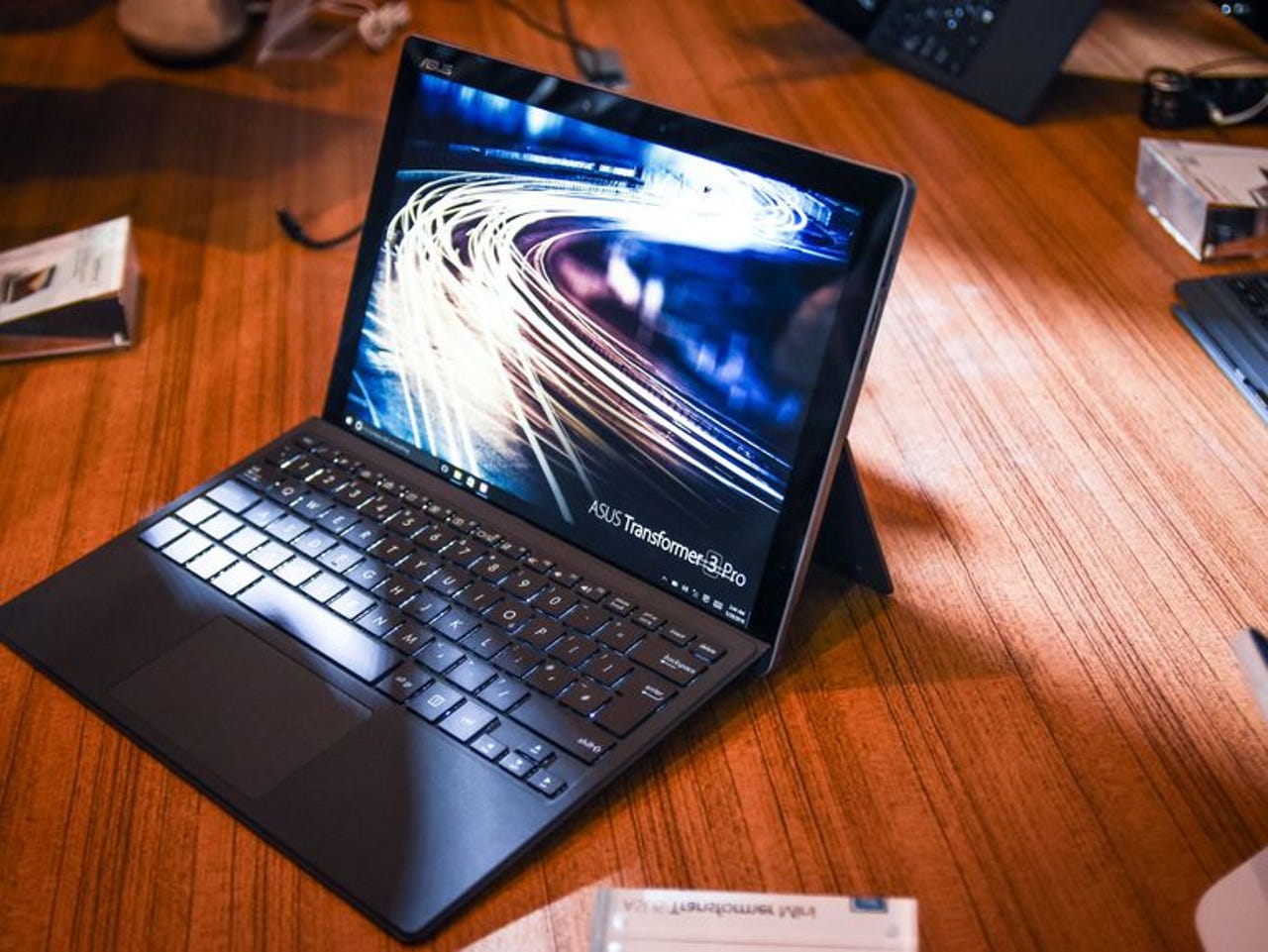Meet the army of Surface Pro clones and lookalikes

Surface Pro 4's innovations inspire an army of imitators
After the disastrous launch of the original Microsoft Surface RT, it's hard to imagine that five years later the Surface brand would be attached to a full line of PCs and peripherals that together make up a billion-dollar business for Microsoft.
The Surface Pro 4 is a refined version of the original Surface Pro, which I called "brilliant, quirky, and flawed" in my original review. It's still brilliant and quirky, but the flaws have been mostly engineered away.
In a testament to how well the Surface Pro has defined a category, consider the number of imitators it's spawned, all with their own takes on kickstands and detachable keyboards.
RELATED
Chuwi's crowd-sourced knock-off
Chuwi, a small Chinese hardware maker, teased its Surface Pro knock-off in April and then launched a crowdfunding campaign in May.
At $300-$400, the SurBook is half the price of the entry-level Surface Pro. It uses a lower-spec Intel Apollo Lake processor but otherwise is competitive on paper. The presence of a USB Type-C port means it's compatible with a host of peripherals.
Until it ships, it's hard to say whether Chuwi's entry represents serious competition or is just a cheap imitator.
RELATED
Dell's Latitude 5285 is a gray-flannel Surface Pro clone
My ZDNet colleague Adrian Kingsley-Hughes ticked off a long list of features that Dell's business-focused Latitude 5285 has in common with the Surface Pro: Both series include seventh-generation Intel Core processors, a detachable keyboard, and a pen.
There's also a built-in kickstand that one-ups the Surface Pro with its ability to extend automatically. Unlike the Surface Pro, which has zero USB Type-C ports, this Dell has two, along with options for fingerprint and smartcard readers as well as LTE support.
The one disappointment is the display. The Surface Pro 4 has a glorious 2736 x 1824 screen, while Dell (presumably for budget reasons) stuck with the more traditional Full HD (1920 x 1080) option.
RELATED:

ASUS takes the high road with its Transformer 3 Pro
In her ZDNet review of ASUS's entry into the Surface Pro 4 look-alike derby, Sandra Vogel finds a lot to like: Excellent build quality, an effective kickstand, a detachable keyboard and pen that are included with the basic unit, high-end CPU and storage options (including a 1TB PCI3 x4 SSD), and USB Type-C support.
The 2880 x 1920 display uses the same 3:2 aspect ratio as the Surface Pro, and the screen is even a little larger,
The flaws? Poor sound quality and (perhaps a dealbreaker for most buyers) a battery that routinely runs out in less than five hours.
RELATED
Samsung's hit-and-miss Galaxy Book
ZDNet's Matthew Miller, who's used a Surface Pro 4 as a primary PC for more than a year, gave Samsung's Surface Pro 4 lookalike a spin.
He liked the AMOLED display, which has the same resolution and aspect ratio as Microsoft's model but with richer blacks, making it an excellent movie-watching device.
Not surprisingly, Samsung also includes two USB Type-C ports and offers fast charging.
Alas, the absence of Windows Hello face authentication support and the limited angles available for the keyboard folio made it difficult to recommend the Samsung Galaxy Book over the Surface Pro 4.
RELATED
Huawei flexes its hardware design chops
We haven't yet seen the MateBook X, but on paper it looks like a solid competitor to the Surface Pro 4, with a premium price tag to match its premium specs.
ZDNet's Matthew Miller reports on the specs:
The top-of-the-line model in this series of three new MateBooks is the MateBook X. It has a 13-inch Gorilla Glass display with a stunning 88-percent screen-to-body ratio, thanks to minimized 4.4mm bezels. It is only 12.5mm thick, too. The MateBook X includes a 7th-generation Intel Core i7 or i5 process, Dolby Atmos sound, and integration of Huawei's blazing fast and accurate smartphone fingerprint scanner as part of the power button.
Like the Surface Pro line, the MateBook X has a 3:2 aspect ratio with 2160 x 1440 pixels. It weighs in at 2.31 pounds and comes in space gray, prestige gold, and rose gold colors. You can select 4GB or 8GB of RAM and 256GB or 512GB SSD.
Of course, it includes the de rigueur USB Type-C report as well.
RELATED
Lenovo goes for an affordable homage
Kickstand? Check. Detachable keyboard? Check.
Beyond those two must-have features, this Surface Pro 4 alternative is decidedly lower in its specifications than Microsoft's model. The 1920 x 1200 IPS screen, for example, is a big step down from the Surface Pro's PixelSense display. But the lower pricetag should make up for that.
ZDNet's review dings Lenovo's mid-range entry disappointing battery life and a tendency to run warm, which in turn leads to annoying fan noise.
RELATED
HP has a worthy contender in its Spectre X2
The new Spectre X2 is an eagerly awaited alternative to the Surface Pro, especially in its base model. That entry has a seventh-gen Core i5 (Kaby Lake) processor, compared to the Core M3 in the Surface Pro, plus 8GB of RAM, double what Microsoft offers.
It also has a higher-resolution screen, at 3000 x 2000, and includes the pen and detachable keyboard in the $1000 base price.
The big question mark is battery life. With a claimed battery life of 8 hours, the Spectre X2 beates the Surface Pro 4 but falls short of the new Surface Pro (2017) model.
RELATED
HP's Elite X2 is a business-class upgrade
This is another Surface Pro alternative that's been announced but won't arrive until July 2017. It's thinner than its Microsoft rival, and it has the latest Intel Kaby Lake CPUs as well as a hollow take on the kickstand that gives it a distinctive look.
ZDNet's Sean Portnoy notes some of the business-class features that are available in the Elite model line: It's built to MIL-SPEC rugged standards, and it also includes the HP Collaboration Keyboard and a Wacom digital pen.
HP also makes it easier to open up the device for repairs and upgrades, something that's nearly impossible to do with the notoriously clamped-down Surface Pro hardware.
RELATED
Samsung Galaxy TabPro S is a tablet with PC features
As ZDNet's Matthew Miller writes, this entry from Samsung is a worthy contender for those who want to use a Windows device primarily in tablet mode.
The TabPro S is powered by an Intel Core m3 CPU. The display, slightly smaller than the Surface Pro alternative, uses Samsung's superb AMOLED technology, running at a native resolution that's identical to its Microsoft rival. It's a few grams lighter than either the Surface Pro 4 or the iPad Pro.
The keyboard isn't backlit, and its layout is smaller than the Type Cover. Instead of a kickstand, it has a folio case with two viewing angles.
If you've objected to the Surface Pro 4 because it's too much like a PC and to the iPad Pro because it's not enough of a PC, consider this the middle ground.
RELATED
Apple's iPad Pro is close enough to a PC for many uses
It's hard not to look at the iPad Pro and think it was introduced at least partly because of competitive pressure from the Surface family of devices.
As a 2-in-1, the larger iPad Pro with its 12.9 inch screen and Apple Pencil offers tool that creative types love. Thanks to Apple's A9X chip, this device performs like a respectable laptop, and with the addition of Apple's Smart Keyboard it acts enough like a PC to satisfy a lot of use cases.
Where the iPad Pro stumbles is in the other things that make a PC a PC: USB connectivity (nope), mouse support (sorry), full desktop apps (although the available options are adequate), and access to the file system (will probably never happen).
If you're not bothered by those limitations or the hefty pricetag, the iPad Pro is perfectly capable of playing the same role as a hybrid PC.
RELATED